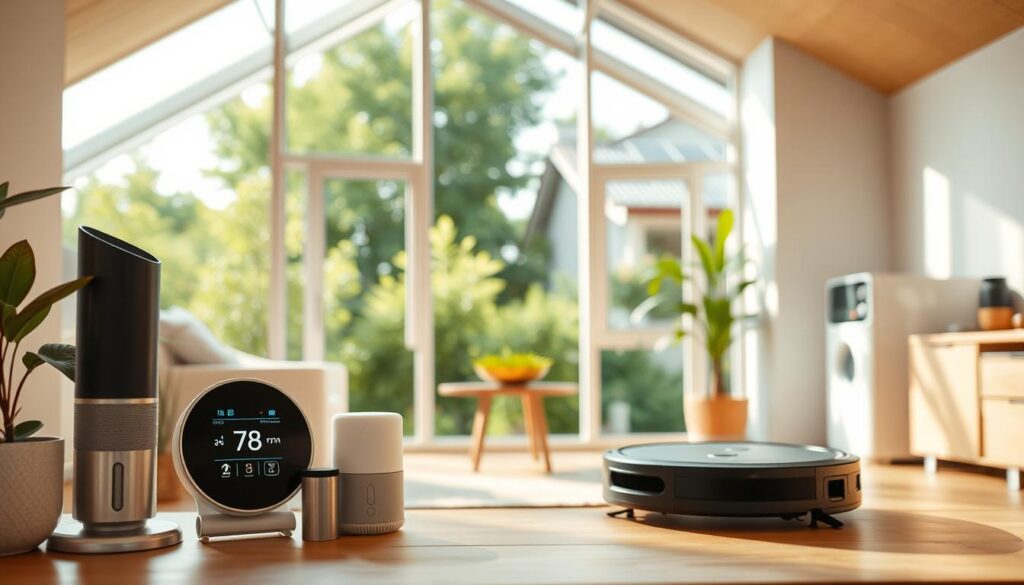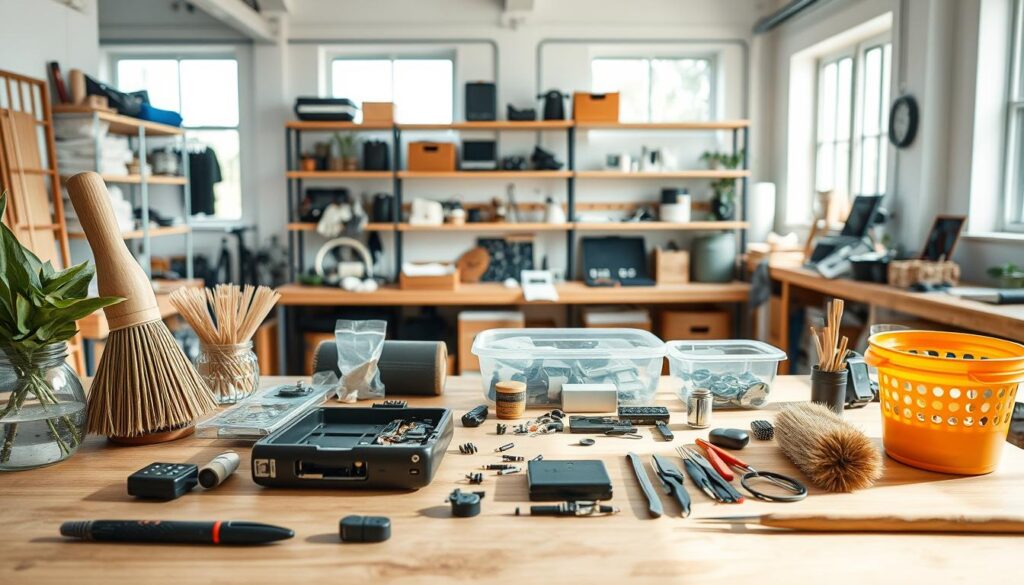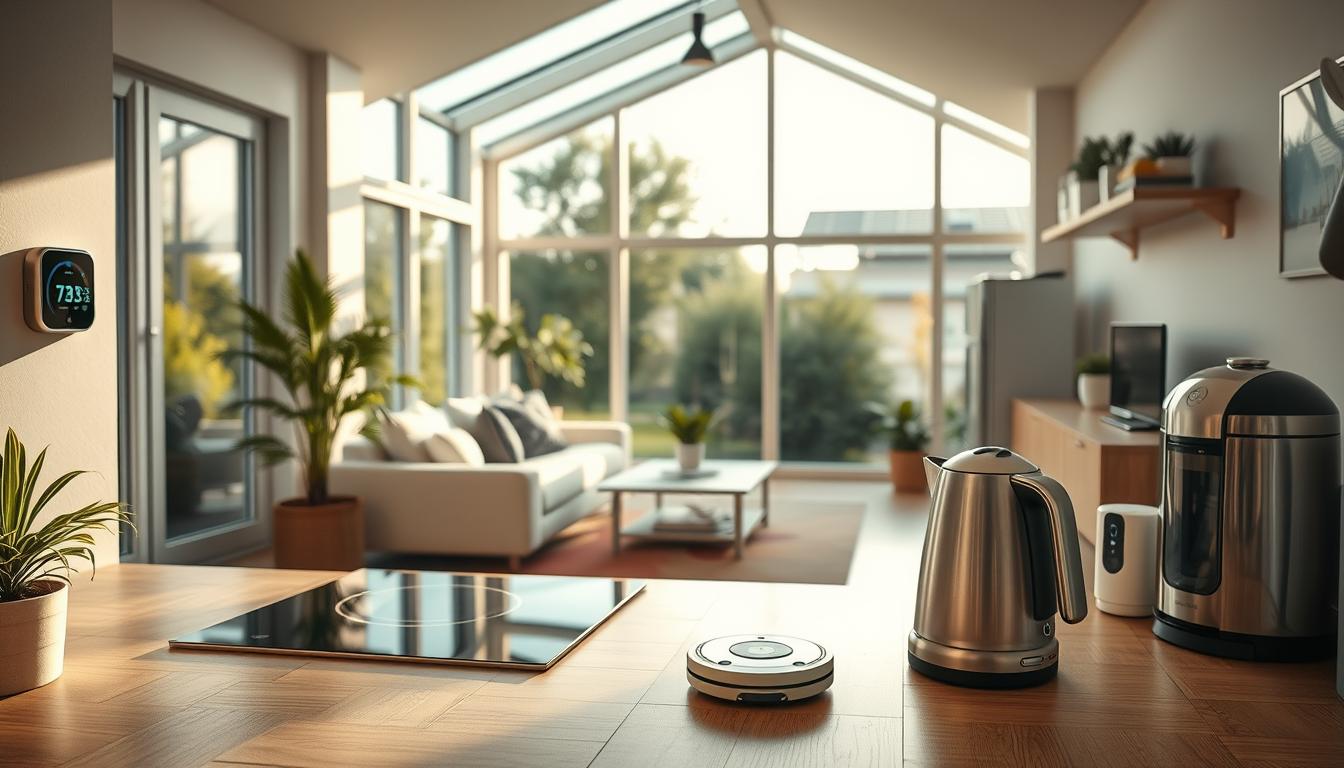Eco-friendly gadgets for home are reshaping everyday life. They cut energy use, slash waste, and turn living spaces into hubs of sustainability. From smart bulbs to solar chargers, these tools blend tech with Earth-friendly choices.
Modern homes now use devices like Philips Hue lights or Google Nest thermostats. They learn habits, adjust settings automatically, and save resources. Eco-friendly gadgets for home prove that going green doesn’t mean sacrificing comfort—they make life easier while reducing footprints.
Key Takeaways
- Eco-friendly gadgets for home reduce energy bills and carbon emissions.
- Smart tech like sensors and timers optimizes resource use in daily routines.
- Products such as solar chargers and LED bulbs last longer, lowering waste.
- These devices boost home value while aligning with global sustainability goals.
- Investing in them supports cleaner energy trends and long-term savings.
Understanding Eco-friendly Gadgets for Home
Discover how sustainable home products transform everyday living. These innovations blend technology with environmental care, making eco-conscious choices effortless.
Defining Sustainable Home Tech
Sustainable home tech combines practicality with planet-friendly design. Devices like Philips Hue Smart Bulbs or Nest Thermostats use less energy and smart features to cut waste. Materials matter too: brands like EcoSmart build gadgets from recycled plastics or renewable resources. Look for certifications like ENERGY STAR or Cradle to Cradle for verified eco-credentials.
Key Benefits and Environmental Impact
- Cost Savings: Upgrading to sustainable home products lowers energy bills. A LG ThinQ fridge uses 40% less power than older models.
- Resource Conservation: Solar-powered gadgets, like Goal Zero chargers, reduce reliance on fossil fuels.
- Longevity: Built to last, these products cut e-waste. For example, Ecovative packaging uses mushroom-based materials that decompose naturally.
Every choice matters. Switching to sustainable home products today builds a greener tomorrow—one gadget at a time.
Innovations in Environmentally Friendly Devices
Green home technology continues to evolve, bringing smarter solutions to reduce energy use and waste. New devices now merge advanced tech with sustainability, making eco-friendly living easier than ever.
- Solar-integrated windows that generate electricity while blocking UV rays
- AI-driven irrigation systems that adjust watering based on soil moisture
- Recyclable smart sensors for monitoring energy use in real time
| Innovation | Technology | Benefits |
|---|---|---|
| Solar windows | Transparent photovoltaic film | Cuts electricity bills by 30% |
| Smart irrigation | Machine learning sensors | Saves up to 50% water use |
| Recyclable sensors | Biodegradable materials | Eliminates e-waste from tech upgrades |
Companies like Tesla and Nest are leading the way with solar roofs and self-learning thermostats. These advancements show how green home technology adapts to modern lifestyles without sacrificing convenience. From kitchen appliances to outdoor systems, every part of the home can now benefit from these eco-smart upgrades.
Sustainable Home Products for a Greener Living
Modern homes are adopting environmentally friendly devices that merge style with sustainability. From smart systems to energy-saving appliances, these innovations make eco-conscious living practical and accessible.
How Green Home Technology is Evolving
Today’s advancements focus on reducing waste and energy use. Smart sensors adjust lighting and climate automatically, cutting electricity bills and carbon footprints. Solar-powered chargers and Wi-Fi enabled recycling bins are now part of everyday tech.
- Smart thermostats learn routines to save 10-30% on heating costs.
- Solar panels with battery storage provide 24/7 clean energy.
- Water-saving showerheads reduce usage without sacrificing pressure.
Examples of Eco-conscious Home Gadgets
Leading brands offer solutions that align with eco goals:
| Product | Features | Eco Benefits |
|---|---|---|
| Philips Hue Smart Bulbs | Adjustable lighting via app | Uses 80% less energy than incandescent bulbs |
| EcoFlow Delta Power Station | Portable solar battery | Powers homes during outages using renewable energy |
| LG ThinQ Smart Fridge | AI manages food storage | Cuts energy use by optimizing temperature settings |
These environmentally friendly devices integrate seamlessly into daily life. Upgrading to such gadgets isn’t just good for the planet—it’s a step toward smarter, healthier living spaces.
The Rise of Energy-efficient Household Items
Energy-efficient household items are transforming homes across the U.S., combining smart design with eco-conscious goals. From refrigerators to light fixtures, these items cut energy use without sacrificing performance. Market research shows a 15% rise in U.S. sales since 2020, driven by incentives like federal tax credits and consumer demand for sustainability.
- LED lighting reduces energy use by up to 80% compared to incandescent bulbs.
- Smart thermostats like Nest save 10-12% on heating costs annually.
- Energy Star-certified appliances lower utility bills while meeting strict efficiency standards.
“Consumers are prioritizing products that save money and protect the planet,” says the Alliance to Save Energy. “Innovations in insulation, solar integration, and AI-driven systems are making these items essential for modern living.”
These items empower homeowners to shrink their carbon footprint. ENERGY STAR® certified refrigerators, for instance, use 20% less energy than standard models. Solar-powered gadgets and Wi-Fi enabled power strips let users track and reduce consumption in real time. As tech improves, these energy-efficient household items are becoming must-haves for eco-aware families. The shift isn’t just about saving money—it’s a step toward a greener future everyone can participate in.
Green Home Technology: Modern Innovations
Modern homes now embrace eco-conscious home gadgets that blend cutting-edge tech with sustainability. From AI-driven energy management to seamless device connectivity, these innovations transform daily routines while reducing environmental footprints. See how these tools save resources and money below.
Smart Features and Connectivity
Today’s eco-conscious home gadgets use Wi-Fi and voice commands to optimize energy use. For example, the Nest Learning Thermostat learns routines to adjust heating/cooling automatically. Similarly, Philips Hue Smart Lighting dims bulbs via apps, cutting electricity waste. These devices sync with smart hubs like Amazon Alexa, creating a unified green ecosystem.
Cost Savings and Efficiency Improvements
- Smart irrigation systems like Bosch Smart Water Timer reduce outdoor water use by 30%.
- Solar-powered chargers, such as those from Goal Zero, slash grid dependency.
- Energy monitors like TP-Link Kasa track usage, helping users cut bills by 20% yearly.
“Smart eco-tech isn’t just a trend—it’s a practical way to save money while protecting the planet.” — GreenTech Innovations Report 2023
Choosing the Best Eco-friendly gadgets for home
Picking the right eco-friendly gadgets starts with clear goals. Look for devices that align with your home’s needs and sustainability priorities. Here’s how to simplify the process:
Factors to Consider Before Purchase
- Energy ratings: Check ENERGY STAR® certifications for appliances like refrigerators or washing machines.
- Material sourcing: Brands like Ecovative use mushroom-based packaging, reducing plastic waste.
- Longevity: Invest in devices with modular designs, such as Philips Hue bulbs that last 15,000+ hours.
| Certification | Key Benefits |
|---|---|
| Energy Star | Guaranteed energy savings |
| EU Ecolabel | Low environmental impact across lifecycle |
Integrating Devices into Your Home Setup
Pair new gadgets with existing tech for maximum efficiency. For example, link smart thermostats like Nest Learning Thermostat to home automation systems.

“Compatibility and scalability are key to avoiding tech clutter.” – Green Tech Review, 2023
Start small: Begin with a solar-powered charger or LED bulbs. Gradually add complex systems like Samsung’s SmartThings for full home control. Always prioritize brands offering recycling programs for old devices.
Tips for Integrating Green Tech into Your Living Space
Transform your home into an eco-friendly hub with these easy strategies. Green tech integration doesn’t require a full renovation—small choices add up to big impacts.
Practical Steps for a Sustainable Home
Begin by mapping your energy habits:
- Start with a free energy audit via tools like the U.S. Department of Energy’s guide.
- Replace one device at a time, like swapping old bulbs for Philips Hue smart LEDs.
- Pair gadgets with existing systems—smart plugs work with any appliance to cut standby power.
| Step | Action | Result |
|---|---|---|
| 1 | Upgrade to Wi-Fi enabled thermostats (e.g., Nest Learning Thermostat) | Cuts heating costs by 10-15% annually |
| 2 | Install water-saving showerheads from brands like Delta Faucet | Reduces water use without sacrificing pressure |
| 3 | Use app-based dashboards like EcoMaster Pro | Track real-time energy savings across devices |
Maximizing Efficiency with Green Gadgets
- Set routines for smart devices. Program lights and HVAC to shut off when rooms are empty.
- Layer tech strategically: A smart power strip (e.g., Belkin WeMo) cuts phantom power drain by 30%.
- Reuse old tech—donate outdated devices to schools or nonprofits instead of trashing them.
Pair gadgets with habits. Turn off devices during vacations to save 5% more energy. Small swaps create a greener routine everyone can follow.
Maintenance and Longevity of Eco-Conscious Home Gadgets
Keeping eco-gadgets in top shape ensures they work efficiently for years. Proper care reduces waste and saves money over time. Follow these steps to make your devices last longer and function at peak performance.
Care Tips for Prolonging Device Life
- Clean regularly: Wipe solar panel surfaces with soft cloths and avoid harsh chemicals on smart device screens.
- Store in dry areas to prevent corrosion in devices like Philips rechargeable batteries.
- Charge devices correctly—never let lithium-ion batteries (e.g., Ecovacs robot vacuums) drain fully before recharging.
- Use protective cases for portable gadgets like Nest thermostats to avoid damage.

“Maintaining smart tech properly can extend its lifespan by 50%, cutting e-waste.”
When to Upgrade Your Technology
- Performance drops: If a LG smart fridge’s energy efficiency falls below 70%, consider upgrading.
- Outdated software: Non-upgradable devices like old Belkin smart plugs may need replacing for security.
- High repair costs: Fixing a broken Ecobee thermostat may cost more than buying an energy-efficient model.
Balance care with upgrades to align with newer Wi-Fi enabled or solar-integrated systems. Prioritize longevity to maximize eco and cost benefits.
Future Trends in Sustainable Home Technology
Smart homes are set to become even greener. Upcoming trends promise devices that learn, adapt, and reduce waste. Analysts predict 40% growth in eco-friendly smart devices by 2025, driven by consumer demand for cleaner energy solutions.
“Homes of tomorrow will generate more energy than they consume,” said Dr. Lena Torres, sustainability researcher at Greentech Labs.
| Trend | What It Means | Impact |
|---|---|---|
| AI-Powered Efficiency | Devices using AI to automate energy use | Cuts household emissions by up to 25% |
| Biodegradable Electronics | Gadgets made from compostable materials | Eliminates 90% of e-waste from tech |
| Off-Grid Systems | Solar and wind tech integrated into everyday appliances | Reduces reliance on non-renewable grids |
Companies like Philips and Tesla are already testing solar-powered air purifiers and self-charging lights. These innovations aim to make sustainability effortless. Upgrading to these systems now can save up to $500 annually on utility bills while reducing your carbon footprint.
Conclusion
Eco-friendly gadgets are more than just trends—they’re tools for a smarter, sustainable future. From smart thermostats like Nest to energy-saving LED bulbs from Philips, these devices cut waste while boosting comfort. Every choice, from choosing a solar panel system to using a LG InstaView fridge with low energy use, adds up to big environmental wins.
Adopting green tech isn’t just about saving money on bills; it’s about building a healthier planet. Brands like EcoFlow and Samsung continue innovating, making it easier than ever to reduce your carbon footprint. By integrating these solutions, you join a movement that balances modern living with ecological responsibility.
Start small: swap old appliances for Energy Star-certified models or install a smart plug to monitor usage. Each step brings you closer to a home that’s efficient, affordable, and kind to the Earth. The future of home tech is here—make it part of your everyday life today.
FAQ
What are eco-friendly gadgets for home?
Eco-friendly gadgets for home are devices designed to reduce energy consumption and minimize environmental impact. They include energy-efficient household items, sustainable home products, and green home technology that promote a healthier living space.
How do I know if a product is truly eco-friendly?
Look for certifications like Energy Star, LEED, or other eco-labels that indicate a product meets specific environmental standards. Additionally, check for sustainable materials, energy-efficient performance, and the manufacturer’s commitment to eco-conscious practices.
What are some examples of sustainable home tech?
Examples of sustainable home tech include smart thermostats like the Nest Learning Thermostat, energy-efficient LED bulbs, solar-powered chargers, and water-saving devices like low-flow showerheads. These eco-conscious home gadgets help reduce energy bills and environmental impact.
Can eco-friendly gadgets really save me money?
Yes! Investing in energy-efficient household items can lead to significant savings on your energy bills over time. For example, smart power strips and energy-efficient appliances help lower electricity costs while benefiting the environment.
How can I integrate green home technology into my existing setup?
Start by assessing your current devices and identifying which ones can be replaced with energy-efficient or eco-friendly alternatives. When choosing new gadgets, ensure they are compatible with your existing systems and have user-friendly features to maximize efficiency.
What maintenance is required for eco-conscious home gadgets?
Regular maintenance includes cleaning devices, updating software for smart gadgets, and monitoring performance. Following the manufacturer’s care tips can help prolong the life of your eco-friendly gadgets and ensure they operate at peak efficiency.
Are there any emerging trends in sustainable home technology?
Yes, the market is seeing a shift towards innovations like smart home ecosystems that enhance connectivity among devices, advancements in renewable energy sources, and smarter automation features that further improve energy efficiency in households.
What factors should I consider when choosing eco-friendly gadgets?
Consider factors such as energy efficiency ratings, compatibility with your existing setup, ease of use, the quality of materials, and long-term benefits versus short-term costs. Researching customer reviews can also help inform your decision.
